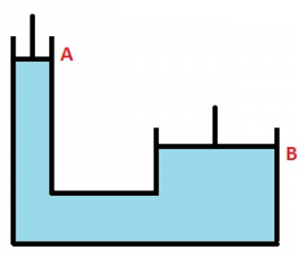Class11th science physics (Mechanical Properties Of Fluids)
Fluids are the substances which move or flow in a certain direction when an external force is applied to them. Fluids can be either gases or liquids. However, when we study fluids and their mechanical properties, we come across two topics namely hydrodynamics and hydrostatics.
What is Hydrostatic?
Hydrostatic is basically concerned with fluids at rest while hydrodynamics deals with fluids which are in motion.
What is Pascal’s Law?
When a fluid is at rest, the pressure on the liquid is the same at all points provided, they are of the same height. The change in pressure which has been applied on the fluid which is enclosed can be transmitted undiminished to every point of the fluid and the container vessel’s walls.
When an incompressible fluid is passing between every second in a pipe of non-uniform cross-section, the volume will be the same as the steady flow. Bernoulli’s principle is an equation which states the conservation of energy of non-viscous fluid motion in a steady state.
What is Reynold’s Number?
Reynolds number is referred to the onset of turbulence in a fluid flow which can be determined by a dimensionless parameter.
What is Surface Tension?
It is referred to the force per unit length which is acting on the plane of the interface between the bonding surface and the liquid. It is the amount of the extra energy which the molecules at the interface have when compared to the interior.
Consider the image given below. The column is filled with water. The ends of each column A and B have been blocked by a piston. If piston A is pressed, what do you think will happen to piston B? Piston B is going to rise up. We have just applied Pascal’s law to our fluid column. So what is Pascal’s law?

What is Pascal’s Law?
According to this principle, the external static pressure applied on a confined liquid is distributed or transmitted evenly throughout the liquid in all directions. The static pressure acts at right angles to any surface in contact with the fluid. Pascal also found that the pressure at a point for a static fluid would be same across all planes passing through that point in that fluid.
Example of Pascal’s Law:
Let us understand the working principle of Pascal’s law with an example.
A pressure of 2000 Pa is transmitted throughout a liquid column due a force being applied on a piston. If the piston has an area of 0.1 m2, what is the force applied?
This can be calculated using Pascal’s Law formula.
F = PA,
Where,
F is the force applied
P is the pressure transmitted
A is the cross sectional area
Here,
P = 2000 Pa = N/m2
A = 0.1 m2
Substituting values, we arrive at F = 200 N
Applications of Pascal’s Law
- Hydraulic Lift: The image you saw at the beginning of this article is a simple line diagram of a hydraulic lift. This is the principle of working of hydraulic lift. It works based on the principle of equal pressure transmission throughout a fluid (Pascal’s Law).
- The construction is such that a narrow cylinder (in this case A) is connected to a wider cylinder (in this case B). They are fitted with airtight pistons on either end. The inside of the cylinders are filled with an incompressible fluid.
- Pressure applied at piston A is transmitted equally to piston B without diminishing, on use of an incompressible fluid. Piston B effectively serves as a platform to lift heavy objects like big machines or vehicles. Few more applications include a hydraulic jack and hydraulic press and forced amplification is used in the braking system of most cars.
Comments
Post a Comment